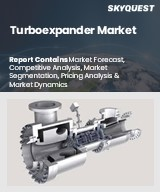
|
시장보고서
상품코드
1772732
터보 익스팬더 시장 규모, 점유율, 성장 분석 : 제품 유형별, 부하 장비별, 출력 용량별 - 산업 예측(2025-2032년)Turboexpander Market Size, Share, and Growth Analysis, By Product Type (Axial Flow, Radial Flow), By Loading Device (Compressor, Generator), By Power Capacity - Industry Forecast 2025-2032 |
||||||
세계의 터보 익스팬더 시장 규모는 2023년에 13억 달러로 평가되며, 2024년 13억 7,000만 달러에서 2032년까지 20억 5,000만 달러로 성장하며, 예측 기간(2025-2032년)의 CAGR은 5.2%로 성장할 전망입니다.
터보 익스팬더 세계 시장은 천연가스 및 액화천연가스에 대한 수요 증가와 산업용 에너지 회수 및 극저온 용도에서 터보 익스팬더의 사용으로 성장하고 있습니다. 터보 익스팬더 기술의 발전과 지열 에너지에서의 채택 증가는 시장 확대에 크게 기여하고 있습니다. 지속가능성에 대한 관심은 천연가스 및 에너지 회수 솔루션의 사용을 촉진하고 매출 전망을 높이고 있습니다. 또한 산소, 질소, 아르곤과 같은 산업용 가스를 위한 공기 분리 장비에 대한 수요가 액화 공정에서 터보 익스팬더의 사용을 지원하고 있습니다. 그러나 가혹한 환경에서의 운영의 어려움, 높은 초기 투자 비용, 유지보수 비용, 석유 및 가스 가격 변동, 대체 기술과의 경쟁 등의 문제가 이 분야의 매출을 저해할 수 있습니다.
목차
서론
- 조사의 목적
- 조사 범위
- 정의
조사 방법
- 정보 조달
- 2차와 1차 데이터 방법
- 시장 규모 예측
- 시장의 전제조건과 제한
개요
- 세계 시장 전망
- 공급과 수요 동향 분석
- 부문별 기회 분석
시장 역학과 전망
- 시장 개요
- 시장 규모
- 시장 역학
- 촉진요인과 기회
- 억제요인과 과제
- Porter의 산업 분석
주요 시장 인사이트
- 주요 성공 요인
- 경쟁의 정도
- 주요 투자 기회
- 시장 에코시스템
- 시장의 매력 지수(2024년)
- PESTEL 분석
- 거시경제 지표
- 밸류체인 분석
- 가격 분석
세계의 터보 익스팬더 시장 규모 : 제품 유형별·CAGR(2025-2032년)
- 시장 개요
- 축류
- 레이디얼 플로우
세계의 터보 익스팬더 시장 규모 : 부하 장비별·CAGR(2025-2032년)
- 시장 개요
- 컴프레서
- 제너레이터
- 유압/오일 - 브레이크
세계의 터보 익스팬더 시장 규모 : 전력 용량별·CAGR(2025-2032년)
- 시장 개요
- 1MW 미만
- 1MW-4MW
- 5MW-9MW
- 10MW-19MW
- 20MW-24MW
- 25MW-40MW
- 40MW 이상
세계의 터보 익스팬더 시장 규모 : 용도별·CAGR(2025-2032년)
- 시장 개요
- 공기 분리
- 석유 및 가스 처리
- 저온 응용
- 기타
세계의 터보 익스팬더 시장 규모 : 최종 용도별·CAGR(2025-2032년)
- 시장 개요
- 석유 및 가스
- 에너지와 전력
- 화학·석유화학제품
- 기타
세계의 터보 익스팬더 시장 규모·CAGR(2025-2032년)
- 북미
- 미국
- 캐나다
- 유럽
- 독일
- 스페인
- 프랑스
- 영국
- 이탈리아
- 기타 유럽 지역
- 아시아태평양
- 중국
- 인도
- 일본
- 한국
- 기타 아시아태평양
- 라틴아메리카
- 브라질
- 기타 라틴아메리카 지역
- 중동 및 아프리카
- GCC 국가
- 남아프리카공화국
- 기타 중동 및 아프리카
경쟁 정보
- 상위 5사의 비교
- 주요 기업의 시장 포지셔닝(2024년)
- 주요 시장 기업이 채택한 전략
- 최근 시장 동향
- 기업의 시장 점유율 분석(2024년)
- 주요 기업의 기업 개요
- 기업의 상세
- 제품 포트폴리오 분석
- 기업의 부문별 점유율 분석
- 매출의 전년대비 비교(2022-2024년)
주요 기업 개요
- Atlas Copco AB(Sweden)
- Baker Hughes Company(USA)
- Cryostar SAS(France)
- Air Products and Chemicals Inc.(USA)
- L.A. Turbine(USA)
- Elliott Group(USA)
- MAN Energy Solutions(Germany)
- Siemens Energy(Germany)
- Nikkiso ACD(USA)
- R&D Dynamics Corporation(USA)
- Turbogaz(Ukraine)
- Air Liquide Engineering & Construction(France)
- Hangzhou Hangyang Co., Ltd.(China)
- Kaifeng Air Separation Group Co., Ltd.(China)
- Sichuan Air Separation Plant Group(SASPG)(China)
- Suzhou Xida Cryogenic Equipment Co., Ltd.(China)
- Gaztron Engineering Private Limited(India)
- Anax Power(USA)
- ZJ-Tibo(China)
결론과 제안
KSAGlobal Turboexpander Market size was valued at USD 1.3 billion in 2023 and is poised to grow from USD 1.37 billion in 2024 to USD 2.05 billion by 2032, growing at a CAGR of 5.2% during the forecast period (2025-2032).
The global turboexpander market is experiencing growth driven by increasing demand for natural gas and liquified natural gas, coupled with the use of turboexpanders in industrial energy recovery and cryogenic applications. Advancements in turboexpander technology and their rising adoption in geothermal energy contribute significantly to market expansion. The focus on sustainability promotes the use of natural gas and energy recovery solutions, enhancing revenue prospects. Additionally, the demand for air separation units for industrial gases like oxygen, nitrogen, and argon supports turboexpander usage in liquefaction processes. However, challenges such as operational difficulties in harsh environments, high initial investments, maintenance costs, oil and gas price volatility, and competition from alternative technologies may impede sales in this sector.
Top-down and bottom-up approaches were used to estimate and validate the size of the Global Turboexpander market and to estimate the size of various other dependent submarkets. The research methodology used to estimate the market size includes the following details: The key players in the market were identified through secondary research, and their market shares in the respective regions were determined through primary and secondary research. This entire procedure includes the study of the annual and financial reports of the top market players and extensive interviews for key insights from industry leaders such as CEOs, VPs, directors, and marketing executives. All percentage shares split, and breakdowns were determined using secondary sources and verified through Primary sources. All possible parameters that affect the markets covered in this research study have been accounted for, viewed in extensive detail, verified through primary research, and analyzed to get the final quantitative and qualitative data.
Global Turboexpander Market Segments Analysis
Global Turboexpander Market is segmented by Product Type, Loading Device, Power Capacity, Application, End Use and region. Based on Product Type, the market is segmented into Axial Flow and Radial Flow. Based on Loading Device, the market is segmented into Compressor, Generator and Hydraulic/Oil - Brake. Based on Power Capacity, the market is segmented into Less than 1 MW, 1MW - 4 MW, 5MW - 9MW, 10MW - 19MW, 20MW - 24 MW, 25 MW - 40 MW and Above 40 MW. Based on Application, the market is segmented into Air Separation, Oil & Gas Processing, Cryogenic Application and Others. Based on End Use, the market is segmented into Oil & Gas, Energy & Power, Chemical & Petrochemicals and Others. Based on region, the market is segmented into North America, Europe, Asia Pacific, Latin America and Middle East & Africa.
Driver of the Global Turboexpander Market
The global turboexpander market is experiencing significant growth, primarily driven by the rising focus on sustainable energy solutions, which has heightened the demand for natural gas and liquefied natural gas (LNG) globally. Turboexpanders are essential in cryogenic processes, facilitating effective gas separation and pressure management. As LNG infrastructure continues to expand across various nations, the requirement for highly efficient turboexpanders is escalating. Key regions leading this demand include major natural gas producers, which are expected to contribute significantly to turboexpander sales, reflecting the increasing reliance on advanced technologies for energy efficiency and cleaner energy options.
Restraints in the Global Turboexpander Market
The global turboexpander market faces several challenges that can hinder its growth. Turboexpanders are typically subjected to extreme operating conditions, including elevated pressures, low temperatures, and exposure to corrosive gases. Such harsh environments contribute to significant wear and tear, prompting manufacturers to invest in specialized materials and intricate design modifications to enhance the durability of their products. However, these enhancements can also complicate the design, making installation and maintenance more challenging for end users. As a result, these factors collectively pose obstacles to the effective deployment of turboexpanders in various applications, potentially limiting market expansion and customer adoption.
Market Trends of the Global Turboexpander Market
The Global Turboexpander market is witnessing a significant trend driven by the increasing demand for hydrogen liquefaction and processing. As governments worldwide push towards a hydrogen-based economy, turboexpander manufacturers are strategically aligning their products to meet the unique requirements of this sector. Turboexpanders are essential in achieving the ultra-low temperatures necessary for liquefied hydrogen, enhancing energy efficiency throughout the liquefaction process. This growing focus on hydrogen applications represents a key opportunity for turboexpander companies, positioning them to innovate and develop specialized products that cater to the evolving energy landscape, thereby ensuring long-term growth and market competitiveness.
Table of Contents
Introduction
- Objectives of the Study
- Scope of the Report
- Definitions
Research Methodology
- Information Procurement
- Secondary & Primary Data Methods
- Market Size Estimation
- Market Assumptions & Limitations
Executive Summary
- Global Market Outlook
- Supply & Demand Trend Analysis
- Segmental Opportunity Analysis
Market Dynamics & Outlook
- Market Overview
- Market Size
- Market Dynamics
- Drivers & Opportunities
- Restraints & Challenges
- Porters Analysis
- Competitive rivalry
- Threat of substitute
- Bargaining power of buyers
- Threat of new entrants
- Bargaining power of suppliers
Key Market Insights
- Key Success Factors
- Degree of Competition
- Top Investment Pockets
- Market Ecosystem
- Market Attractiveness Index, 2024
- PESTEL Analysis
- Macro-Economic Indicators
- Value Chain Analysis
- Pricing Analysis
Global Turboexpander Market Size by Product Type & CAGR (2025-2032)
- Market Overview
- Axial Flow
- Radial Flow
Global Turboexpander Market Size by Loading Device & CAGR (2025-2032)
- Market Overview
- Compressor
- Generator
- Hydraulic/Oil - Brake
Global Turboexpander Market Size by Power Capacity & CAGR (2025-2032)
- Market Overview
- Less than 1 MW
- 1MW - 4 MW
- 5MW - 9MW
- 10MW - 19MW
- 20MW - 24 MW
- 25 MW - 40 MW
- Above 40 MW
Global Turboexpander Market Size by Application & CAGR (2025-2032)
- Market Overview
- Air Separation
- Oil & Gas Processing
- Cryogenic Application
- Others
Global Turboexpander Market Size by End Use & CAGR (2025-2032)
- Market Overview
- Oil & Gas
- Energy & Power
- Chemical & Petrochemicals
- Others
Global Turboexpander Market Size & CAGR (2025-2032)
- North America (Product Type, Loading Device, Power Capacity, Application, End Use)
- US
- Canada
- Europe (Product Type, Loading Device, Power Capacity, Application, End Use)
- Germany
- Spain
- France
- UK
- Italy
- Rest of Europe
- Asia Pacific (Product Type, Loading Device, Power Capacity, Application, End Use)
- China
- India
- Japan
- South Korea
- Rest of Asia-Pacific
- Latin America (Product Type, Loading Device, Power Capacity, Application, End Use)
- Brazil
- Rest of Latin America
- Middle East & Africa (Product Type, Loading Device, Power Capacity, Application, End Use)
- GCC Countries
- South Africa
- Rest of Middle East & Africa
Competitive Intelligence
- Top 5 Player Comparison
- Market Positioning of Key Players, 2024
- Strategies Adopted by Key Market Players
- Recent Developments in the Market
- Company Market Share Analysis, 2024
- Company Profiles of All Key Players
- Company Details
- Product Portfolio Analysis
- Company's Segmental Share Analysis
- Revenue Y-O-Y Comparison (2022-2024)
Key Company Profiles
- Atlas Copco AB (Sweden)
- Company Overview
- Business Segment Overview
- Financial Updates
- Key Developments
- Baker Hughes Company (USA)
- Company Overview
- Business Segment Overview
- Financial Updates
- Key Developments
- Cryostar SAS (France)
- Company Overview
- Business Segment Overview
- Financial Updates
- Key Developments
- Air Products and Chemicals Inc. (USA)
- Company Overview
- Business Segment Overview
- Financial Updates
- Key Developments
- L.A. Turbine (USA)
- Company Overview
- Business Segment Overview
- Financial Updates
- Key Developments
- Elliott Group (USA)
- Company Overview
- Business Segment Overview
- Financial Updates
- Key Developments
- MAN Energy Solutions (Germany)
- Company Overview
- Business Segment Overview
- Financial Updates
- Key Developments
- Siemens Energy (Germany)
- Company Overview
- Business Segment Overview
- Financial Updates
- Key Developments
- Nikkiso ACD (USA)
- Company Overview
- Business Segment Overview
- Financial Updates
- Key Developments
- R&D Dynamics Corporation (USA)
- Company Overview
- Business Segment Overview
- Financial Updates
- Key Developments
- Turbogaz (Ukraine)
- Company Overview
- Business Segment Overview
- Financial Updates
- Key Developments
- Air Liquide Engineering & Construction (France)
- Company Overview
- Business Segment Overview
- Financial Updates
- Key Developments
- Hangzhou Hangyang Co., Ltd. (China)
- Company Overview
- Business Segment Overview
- Financial Updates
- Key Developments
- Kaifeng Air Separation Group Co., Ltd. (China)
- Company Overview
- Business Segment Overview
- Financial Updates
- Key Developments
- Sichuan Air Separation Plant Group (SASPG) (China)
- Company Overview
- Business Segment Overview
- Financial Updates
- Key Developments
- Suzhou Xida Cryogenic Equipment Co., Ltd. (China)
- Company Overview
- Business Segment Overview
- Financial Updates
- Key Developments
- Gaztron Engineering Private Limited (India)
- Company Overview
- Business Segment Overview
- Financial Updates
- Key Developments
- Anax Power (USA)
- Company Overview
- Business Segment Overview
- Financial Updates
- Key Developments
- ZJ-Tibo (China)
- Company Overview
- Business Segment Overview
- Financial Updates
- Key Developments
















